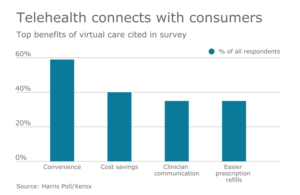Using telehealth to respond to coronavirus concerns
Telehealth, by all accounts, will likely play a major role in responding to the COVID-19 pandemic. The remote provision of clinical services via telecommunications technology, telehealth may help to meet the need for both expanded healthcare resources and for avoidance of in-person contact that may promote disease transmission. In light of COVID-19, regulations restricting telehealth are being relaxed, and private plans are expanding access. Telehealth has been said to be “tailor-made for this moment in time.”
To help illuminate the state of telehealth at this pivotal moment, FAIR Health offers findings from two new publications. One is the third annual edition of our FH Healthcare Indicators and FH Medical Price Index white paper, which examines trends and patterns in healthcare places of service. The other is our brief on COVID-19. Both publications draw on our database of over 30 billion privately billed healthcare claim records, the largest such repository in the country.
Double-digit growth
Of five places of service we studied from 2017 to 2018, telehealth was one of two that grew in utilization, which we measured by private insurance claim lines for services rendered by a given place of service as a percentage of all medical claim lines. (A claim line is an individual procedure listed on an insurance claim.) From 2017 to 2018, telehealth use grew 12% and use of retail clinics grew 10%, but use of urgent care centers, ambulatory surgery centers (ASCs) and emergency rooms (ERs) all declined. Urgent care center use fell 11%, ASC use fell 12% and ER use fell 15%.
Telehealth utilization growth from 2017 to 2018 was not as rapid as in the previous year (2016-2017), when growth was 53%. This shift was part of a larger trend toward slower growth in utilization that affected all five places of service. For retail clinics and telehealth, there was growth in the period 2013-2018, but at a slower rate compared to 2012-2017. For urgent care centers, ASCs and ERs, there was growth in 2009-2018, but at a slower rate compared to 2008-2017.
Limited extent
From 2017 to 2018, telehealth’s percentage of medical claim lines increased slightly, from 0.11% to 0.12%. Still, the percentage in 2018 was small compared to that of ERs (2.22%). The comparable percentages for the other places of service studied were 1.06% for urgent care centers, 0.80% for ASCs and 0.04% for retail clinics.
Codes most often used with respiratory infections
We analyzed the top 10 telehealth codes most often associated with all respiratory infections in 2019, on the assumption that these telehealth codes are likely to be used for COVID-19. The most commonly used code was CPT 99441, telephone evaluation and management (E&M) service by a physician or other qualified healthcare professional (QHP), 5-10 minutes. This code was associated with 50% of all telehealth services for respiratory infections.
Costs for telehealth
The average charge amounts and average estimated allowed amounts for all CPT codes used only for telehealth, based on data from September 2018 to August 2019, are presented below. Four of those codes—CPT 99441, CPT 99442, CPT 99444 and CPT 99443—are among the top 10 telehealth codes associated with the greatest percentage of all telehealth services for respiratory infections.
Among these four codes, the highest costs are associated with CPT 99443 (physician/QHP telephone E&M, 21-30 minutes), with an average charge of $100 and an average estimated allowed amount of $58. The lowest costs are associated with CPT 99441 (physician/QHP telephone E&M, 5-10 minutes), with an average charge of $43 and an average estimated allowed amount of $34.
E&M codes billed both for telehealth and non-telehealth include 4 of the top 10 codes—CPT 99201, CPT 99202, CPT 99212 and CPT 99213—most often associated with respiratory infections. Among these codes, having telehealth as the place of service in most cases yields cost savings by comparison with all places of service for the same code. For example, the average charge amount across all places of service for CPT 99201 (office or other outpatient visit for E&M of a new patient, 10 minutes) is $88, but the average telehealth charge amount for the same code is $55. The average estimated allowed amount across all places of service for this code is $47, while the average telehealth estimated allowed amount is $45.
In this extraordinary time, we hope that our information about telehealth contributes to the national conversation about how our healthcare system can best respond to COVID-19.

